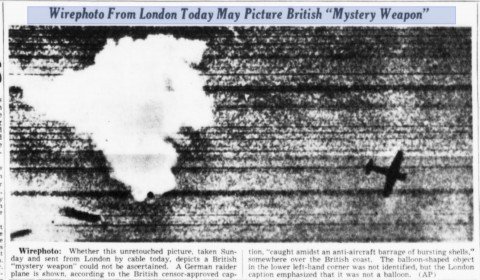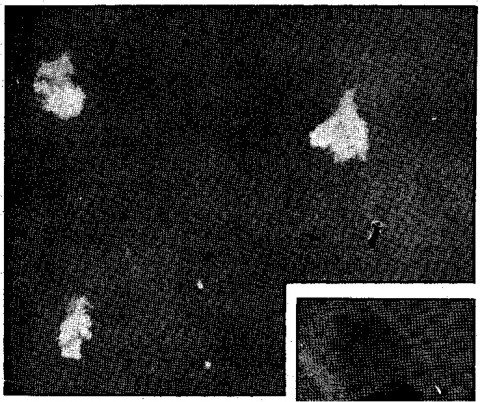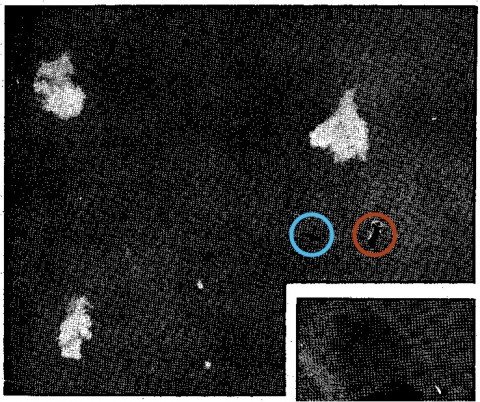Do these photos, taken early in the Battle of Britain, show a British mystery weapon? (I could just say “no”, but that wouldn’t be very interesting, would it.)

The above photo appeared on the front page of an American newspaper, the St Petersburg Evening Independent, on 14 August 1940. The caption reads:
This picture taken Aug. 11 shows, according to British censor-approved caption, a German raider plane “caught amidst an anti-aircraft barrage of bursting shells” — somewhere over the British coast. The balloon-shaped object in lower left-hand corner was not identified, but London caption emphasized it was not a balloon. Whether it was a “mystery weapon” of any nature could not be ascertained. Picture was sent from London by cable as swarms of German raiders continued to batter the British coast.
The same photo, rotated 180 degrees and cropped somewhat differently, appeared on the front page of the Spokane Daily Chronicle the previous day:

Whether this unretouched picture, taken Sunday and sent from London by cable today, depicts a British “mystery weapon” could not be ascertained. A German raider plane is shown, according to the British censor-approved caption, “caught amidst an anti-aircraft barrage of bursting shells,” somewhere over the British coast. The balloon-shaped object in the lower left-hand corner was not identified, but the London caption emphasized that it was not a balloon. (AP)
Because both captions refer to the lower-left corner, but the photos are rotated, it’s not clear whether the mystery object is supposed to be the vaguely blimp-shaped cloudlike object in the top photo, or the black cigar-shape seen in both. I’m not sure what either object actually is — the blimp-shaped thing doesn’t actually look like British barrage balloons of the period, which had three fins; and it would have to be in the process of deflating too. But it could be cloudlike because it is a cloud, or maybe a burst of AA (although it looks very different to the other shellburst). The cigar shape could conceivably be a fighter edge-on, but who knows.
I had a look for the same photograph in British national dailies, and found it in just one, the Daily Mirror of 12 August 1940 (again on the front page). It’s cropped differently again, and is at right angles to both the other versions.

It doesn’t give any more detail than the other two versions (although it does show a much larger area). And the caption only confuses matters, because it doesn’t mention any mystery weapon at all:
Caught in the middle of our anti-aircraft barrage — which German airmen have said “is Hell” — the German plane in the above picture was trying vainly to escape when the camera caught it. You can see the shells bursting around it.
Because the scale is much larger, and because the contrast is very low, I’ve circled the Me 109 (blue) and the blimp-like thing (red) — the cigar-shape doesn’t really show up at all here:

The actual identity of the objects aside, what was going on here? Why did the American papers speculate about a possible British mystery weapon, and the British one didn’t? The proximate cause presumably lies with the captions attached to the photos. The American papers got their copy of the photo from the Associated Press (AP); presumably the Daily Mirror got it from a British bureau or from the Ministry of Information or Air Ministry. The captions are said to be approved by the British censor (presumably meaning the MoI) but that seems to imply that AP actually wrote the captions. Maybe whoever that was had been given some information suggesting that there was a secret air defence weapon in this photo, or maybe they wanted to boost Britain’s chances to the folks back home (the American correspondents in London in 1940, generally speaking, wanted Britain to win and wanted the United States to help it). But either way, no British papers picked up on the secret weapon angle, or were perhaps not permitted to by the censor.
Thanks to Drew Williamson for finding the American items.
![]() This work is licensed under a Creative Commons Attribution-NonCommercial-NoDerivatives 4.0 International License.
Permissions beyond the scope of this license may be available at http://airminded.org/copyright/.
This work is licensed under a Creative Commons Attribution-NonCommercial-NoDerivatives 4.0 International License.
Permissions beyond the scope of this license may be available at http://airminded.org/copyright/.



What fun! First I’m glad too see it was a Messerschmitt 109, and not a Heinkel 113. It’s amazing the number of aces whose combat reports are full of 113s and (later) biographies only refer to 109s…
And would the gentleman from the Daily Mirror please provide his source relaying opinion from the Luftwaffe?
There were visible aerial British ‘secret weapons’ available and some deployed in the period, including stuff like Parachute and Cable (PaC) but the best that can be said for them is that ‘secret’ is what was best about them – next to ‘best forgotten’.
90 gets 1 that it’s just a barrage balloon, things in the sky easily looking ‘odd’ in photos without any effort.
As to the differing reporting on the other sides of the Atlantic, they might have something to do with different expectations of potential British achievement. To generalise wildly, the Brits expected to win by hard graft and that it was going to be a close run thing, but perhaps believed no secret weapons needed*; while (some of) the American public may have been supporting the British, but saw that the W.W.II tote stated Germany had a clean sweep to date – and therefore the odds were against the UK – so a secret weapon might just be the leveller.
(*In fact the efficacy of the RDF (radar) systems and their durability under attack, as well as the system for directing limited numbers of fighters were two very effective British secret weapons in action which, unarguably, were crucial in the Battle.)
Regards,
Yeah, it’s probably a barrage balloon — after all, that’s what the Me 109 was after — but it’s odd that the caption specifically says that it isn’t. (Unless that refers to the cigar-shaped thing …)
About the different expectations: could well be. But it wouldn’t hurt British morale (a key concern at this time) to encourage the belief that they had some secret weapons on their side. Also, in the next few posts I will suggest that this pattern held true before the war as well.
Finally dredged up the notion that may be on the AP annotator’s mind: “aerial mine.” And if the original citation is correct, my guess would be that it is a radio-sonde (i.e. weather balloon) that’s got itself into the middle of the action.
Yes, although it couldn’t actually be an aerial mine, of course, because they weren’t tested until late September (and I think at night, anyway). But the idea itself had been aired in public, so it could well be what the caption writer was thinking of.
I don’t know about a weather balloon. Aren’t they usually spherical? Though I can’t seem to find any pictures of contemporary British examples.
In a world where every single-engined fighter built in quantity has about six hundred books published on it, has anyone ever written even a short and crap history of air-to-air bombing, aerial mines, and their variations?
A good question — I haven’t seen one, but I would probably buy it if I did!
Whatever the object in the bottom left of either picture is, I can’t help but suspect that the ‘mystery weapon’ was invented by rather bored journalists. Just put it in context.
‘Hey bud. What’s this blot in the corner?’
‘Can’t say, old chap.’
‘Is it a balloon?’
‘No! Nothing like it. Fancy another?’
For the life style (and approach to news gathering) of the American correspondent in London read Evelyn Waugh’s Sword of Honour trilogy. (Officers and Gentlemen, I think.)
I do believe he’s got it!
I want to know about the mysterious advent of ~GASP~ colour in a wartime publication. Look, it hovers eerily over the words – the special words.
Nurse!
I choose to believe that journalists are sober, objective purveyors of truth! :) Just like bloggers and historians …
Pingback: Airminded · The superweapon and the Anglo-American imagination — IV